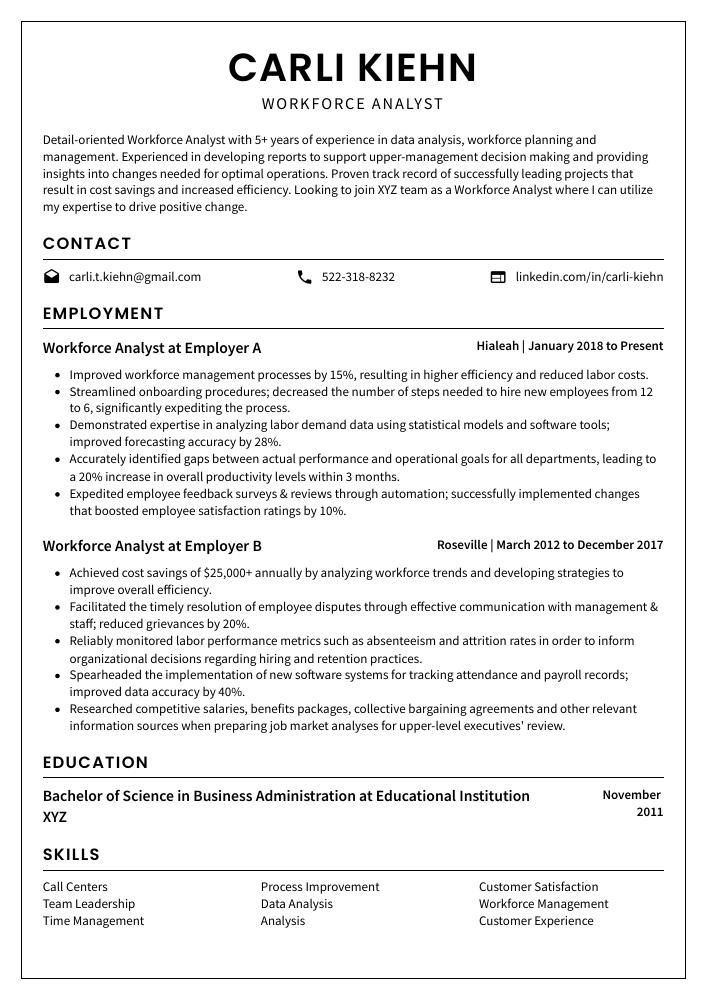Workforce Analyst Resume Guide
Workforce analysts are responsible for analyzing and evaluating the productivity, efficiency, and effectiveness of a company’s workforce. They develop strategies to maximize employee performance based on data collected from the organization’s personnel records. They also analyze trends in labor costs, turnover rates, absenteeism patterns, and other relevant metrics to identify opportunities for improvement within the organization.
You have the skills and knowledge to be an invaluable asset in any workforce. But no one knows you exist. To make sure hiring managers don’t overlook your capabilities, writing a resume that stands out is essential.
This guide will walk you through the entire process of creating a top-notch resume. We first show you a complete example and then break down what each resume section should look like.
Table of Contents
The guide is divided into sections for your convenience. You can read it from beginning to end or use the table of contents below to jump to a specific part.
Workforce Analyst Resume Sample
Carli Kiehn
Workforce Analyst
[email protected]
522-318-8232
linkedin.com/in/carli-kiehn
Summary
Detail-oriented Workforce Analyst with 5+ years of experience in data analysis, workforce planning and management. Experienced in developing reports to support upper-management decision making and providing insights into changes needed for optimal operations. Proven track record of successfully leading projects that result in cost savings and increased efficiency. Looking to join XYZ team as a Workforce Analyst where I can utilize my expertise to drive positive change.
Experience
Workforce Analyst, Employer A
Hialeah, Jan 2018 – Present
- Improved workforce management processes by 15%, resulting in higher efficiency and reduced labor costs.
- Streamlined onboarding procedures; decreased the number of steps needed to hire new employees from 12 to 6, significantly expediting the process.
- Demonstrated expertise in analyzing labor demand data using statistical models and software tools; improved forecasting accuracy by 28%.
- Accurately identified gaps between actual performance and operational goals for all departments, leading to a 20% increase in overall productivity levels within 3 months.
- Expedited employee feedback surveys & reviews through automation; successfully implemented changes that boosted employee satisfaction ratings by 10%.
Workforce Analyst, Employer B
Roseville, Mar 2012 – Dec 2017
- Achieved cost savings of $25,000+ annually by analyzing workforce trends and developing strategies to improve overall efficiency.
- Facilitated the timely resolution of employee disputes through effective communication with management & staff; reduced grievances by 20%.
- Reliably monitored labor performance metrics such as absenteeism and attrition rates in order to inform organizational decisions regarding hiring and retention practices.
- Spearheaded the implementation of new software systems for tracking attendance and payroll records; improved data accuracy by 40%.
- Researched competitive salaries, benefits packages, collective bargaining agreements and other relevant information sources when preparing job market analyses for upper-level executives’ review.
Skills
- Call Centers
- Process Improvement
- Customer Satisfaction
- Team Leadership
- Data Analysis
- Workforce Management
- Time Management
- Analysis
- Customer Experience
Education
Bachelor of Science in Business Administration
Educational Institution XYZ
Nov 2011
Certifications
Certified Workforce Analyst
International Association of Workforce Professionals
May 2017
1. Summary / Objective
A resume summary/objective is the first glimpse a hiring manager gets of who you are and what makes you an ideal candidate for the workforce analyst role. In this section, highlight your most impressive qualifications such as experience with data analysis software, knowledge of labor laws and regulations, or any certifications related to analytics. You can also mention how many years of experience in workforce management you have and why that qualifies you for the position.
Below are some resume summary examples:
Professional and experienced analyst with a track record of success in workforce optimization. Skilled in data analysis, process improvement, and project management to identify cost-effective solutions that improve productivity. At XYZ Corporation, managed the implementation of an automated workforce planning software resulting in a 20% reduction in overhead costs. Received multiple awards for excellence and customer satisfaction throughout my career.
Accomplished workforce analyst with experience in data analysis, forecasting and optimization. At XYZ Corporation, reduced payroll costs by 30% through accurate workforce demand projections. Developed and implemented an innovative approach to labor scheduling that improved employee satisfaction by 20%. Experienced in creating reports for senior management on staffing levels, budgeting needs and other HR-related topics.
Passionate and organized workforce analyst with 5+ years of experience improving employee productivity and engagement through data-driven strategies. Skilled in analyzing trends, monitoring performance metrics, and streamlining processes to optimize team operations at ABC Corporation. At XYZ Company, identified a 10% decrease in labor costs by optimizing scheduling systems for the customer service department.
Proficient workforce analyst with 5+ years of experience driving strategic initiatives and improving operational efficiencies. Seeking to bring proven capabilities in performance measurement, workforce planning, and data analysis to ABC Corporation’s Human Resources Department. At XYZ Inc., identified key areas for cost reduction leading to a $3 million annual savings through optimized staffing levels.
Reliable and detail-oriented workforce analyst with 5+ years of experience in data analysis, trend forecasting, and employee engagement. Skilled at using sophisticated software to uncover insights and develop actionable solutions that increase productivity. Seeking a position as a workforce analyst at ABC Tech where I can apply my expertise to drive positive outcomes for the organization.
Hard-working and detail-oriented workforce analyst with 5+ years of experience in analyzing data to identify trends, develop actionable insights, and recommend solutions. At XYZ Company achieved a 20% reduction in labor costs by utilizing predictive analytics models. Proven ability to work collaboratively across departments while successfully managing multiple projects simultaneously.
Driven workforce analyst with 3+ years of experience in data analytics and project management. Skilled at identifying trends, forecasting labor needs, developing strategies to optimize operations and creating dashboards for effective visualizations. Seeking to join ABC Corp as a Workforce Analyst where I can use my analytical skills to support the company’s growth initiatives.
Determined and analytical Workforce Analyst with 5+ years of experience providing insights into labor trends in the retail industry. Skilled at forecasting, modeling, budgeting, and analyzing data to optimize workforce utilization. At XYZ Retail Group achieved a 10% reduction in employee turnover by implementing innovative staffing strategies based on market research findings.
2. Experience / Employment
Next comes the work history section, which should be written in reverse chronological order, with your most recent job listed first.
Stick to bullet points when writing this section; doing so allows the reader to quickly digest what you have done and achieved. When discussing your work experience, provide detail on what it is that you did and any quantifiable results obtained.
For example, instead of saying “Analyzed workforce data,” you could say, “Conducted a detailed analysis of employee performance metrics across five departments resulting in an 8% increase in productivity.”
To write effective bullet points, begin with a strong verb or adverb. Industry specific verbs to use are:
- Analyzed
- Monitored
- Forecasted
- Optimized
- Evaluated
- Implemented
- Researched
- Developed
- Assessed
- Reported
- Collaborated
- Streamlined
- Documented
- Presented
- Tracked
Other general verbs you can use are:
- Achieved
- Advised
- Compiled
- Coordinated
- Demonstrated
- Expedited
- Facilitated
- Formulated
- Improved
- Introduced
- Mentored
- Participated
- Prepared
- Reduced
- Reorganized
- Represented
- Revised
- Spearheaded
- Structured
- Utilized
Below are some example bullet points:
- Participated in the development of workforce plans and policies by analyzing labor trends, job requirements, staff capacities and employee performance; achieved a 10% reduction in overtime hours.
- Developed actionable strategies to improve workforce efficiency through training sessions on productivity tools, process optimization techniques and new technologies for over 200 employees.
- Reorganized staffing needs across five departments; successfully reduced headcounts by 12% while improving operational output by 15%.
- Forecasted future recruitment demands based on data from existing personnel databases as well as reports from supervisors; accurately forecasted hiring needs up to 6 months ahead of time with 95% accuracy rate.
- Thoroughly evaluated current workloads/projects in order to identify areas where additional resources or manpower could be deployed most effectively; realized cost savings of 5%.
- Utilized advanced analytics tools to analyze labor costs, wages and benefits expenses data, resulting in an 8% decrease in payroll-related costs over the past year.
- Presented findings of workforce analysis reports to senior management, proposing cost optimization strategies that improved budget efficiency by more than $50K annually.
- Coordinated with HR department to develop recruitment plans for new roles; trained and supervised a team of 10+ recruiters in effective interviewing techniques and sourcing methods.
- Reported regularly on key performance indicators such as employee turnover rate, headcount trends & absenteeism levels; identified areas for improvement which led to 12% increase in employee engagement scores within 6 months.
- Actively monitored changes across departments regarding personnel movement & job designations; provided timely updates and feedbacks which facilitated smoother transition process for affected employees during restructuring initiatives.
- Mentored a team of 8 workforce analysts on best practices and procedures regarding the labor force, resulting in improved productivity by 25%.
- Structured an innovative accuracy tracking system that monitored employee workloads, ensuring quality work output with minimal errors; decreased overall employee misclassification rate by 10%.
- Evaluated performance metrics to identify areas of improvement within existing processes, leading to increased efficiency and cost savings of $7000 per month.
- Meticulously tracked data related to job requirements, skill level needed for each position and current staffing levels; reduced time-to-hire process from 30 days to 20 days on average.
- Documented detailed reports outlining labor trends across multiple departments for management review; identified discrepancies between actual staff numbers versus planned budget allocations which resulted in a 9% reduction in operating expenses annually.
- Implemented workforce analysis initiatives that improved employee satisfaction by 25%, resulting in a reduction of labor turnover rate by 10%.
- Introduced innovative strategies for optimizing staff performance, which led to an increase in overall productivity and efficiency by 15%.
- Resourcefully analyzed the existing workforce data to identify gaps in resource utilization and provided solutions with cost savings of over $50,000 annually.
- Collaborated with cross-functional teams to develop comprehensive plans for recruiting new staff members and onboarding them successfully into their positions within two weeks or less on average.
- Accurately forecasted staffing requirements up to 6 months in advance based on market trends & business objectives, ensuring efficient allocation of resources at all times.
- Analyzed workforce trends, productivity metrics and staffing needs to identify opportunities for improvement; decreased labor costs by 15% within the first 6 months.
- Revised employee training programs and operational procedures that resulted in a 10% increase in overall staff efficiency.
- Consistently monitored scheduling systems, attendance records and job performance indicators to ensure optimal resource allocation across multiple departments; identified potential issues before they became costly problems on 3 separate occasions.
- Advised management team on best practices related to recruitment strategies, workplace policies & operations standards with an emphasis on cost-effectiveness; led successful initiatives that saved over $15k annually in recruitment fees alone.
- Represented the company at various HR events such as career fairs, conferences and seminars which helped strengthen employer branding efforts resulting in a 20% boost of qualified applicants per month from targeted demographics.
- Compiled and analyzed extensive data sets to identify workforce trends and develop strategies for managing personnel needs, resulting in a 25% reduction of labor costs over the last year.
- Diligently monitored employee performance metrics such as absenteeism, turnover rates and productivity levels; identified key areas for improvement which led to increased efficiency by 12%.
- Prepared detailed reports on staffing requirements based on current business objectives with recommendations for strategic growth opportunities; enabled successful recruitment of 40+ new staff members within 6 months.
- Formulated comprehensive training plans, implemented reward systems and provided regular feedback sessions geared towards maximizing team performance while minimizing expenses; improved overall motivation among employees by 11%.
- Assessed existing HR processes including payroll management and workflows to ensure compliance with applicable laws & regulations while maintaining cost-effectiveness; reduced total administrative labor time by 20 hours per month on average.
- Optimized workforce utilization rates by 15%, leading to a reduction in labor costs of $25,000 over the course of 6 months.
- Tracked and analyzed employee performance metrics such as attendance and work output on an hourly basis; identified trends that resulted in improved productivity levels across all departments.
- Monitored KPIs for hiring, attrition, training and onboarding processes to improve accuracy and efficiency within the organization’s recruitment cycle; reduced time-to-hire from 3 weeks to 2 weeks with no drop in quality standards.
- Effectively managed budget allocation for staffing needs according to projected workloads & demand forecasts, resulting in savings of 10% compared to previous fiscal year expenditure allocations.
3. Skills
The skillset employers require in an employee will likely vary, either slightly or significantly; skimming through their job adverts is the best way to determine what each is looking for. One organization may need someone who is highly experienced in workforce planning and analytics, while another may be looking for an individual with a strong background in data analysis.
It is important to tailor the skills section of your resume accordingly because many employers use applicant tracking systems that scan resumes for certain keywords before passing them on to a human.
In addition to listing these skills, you can also discuss them further by elaborating on their importance or relevance within other sections such as the summary or experience section.
Below is a list of common skills & terms:
- Access
- Account Management
- Analysis
- Business Analysis
- Business Process Improvement
- Call Center
- Call Centers
- Change Management
- Coaching
- Communication
- Contact Centers
- Customer Experience
- Customer Retention
- Customer Satisfaction
- Data Analysis
- Data Entry
- Employee Relations
- Forecasting
- Human Resources
- Operations Management
- Outsourcing
- Performance Management
- Process Improvement
- Program Management
- Project Planning
- Quality Assurance
- Recruiting
- SQL
- Team Leadership
- Team Management
- Teamwork
- Telecommunications
- Time Management
- Troubleshooting
- Vendor Management
- Workforce Management
- Workforce Planning
4. Education
Including an education section on your resume will depend on how far along you are in your career. If you just graduated and have no prior experience, mention your education below your resume objective. However, if you have significant work experience to showcase, it might not be necessary to include an education section at all.
If including an education section is relevant for the workforce analyst role applied for, try to highlight courses taken related to data analysis or any other technical skills that demonstrate a mastery of the field.
Bachelor of Science in Business Administration
Educational Institution XYZ
Nov 2011
5. Certifications
Certifications are a great way to demonstrate your expertise in a particular field. They show potential employers that you have taken the time and effort to become certified, which is an indication of dedication and commitment.
Including certifications on your resume can help give you an edge over other applicants who may not be as qualified or experienced in the same area. If there are any relevant certifications for the job you’re applying for, make sure they are included prominently on your resume so hiring managers can easily spot them.
Certified Workforce Analyst
International Association of Workforce Professionals
May 2017
6. Contact Info
Your name should be the first thing a reader sees when viewing your resume, so ensure its positioning is prominent. Your phone number should be written in the most commonly used format in your country/city/state, and your email address should be professional.
You can also choose to include a link to your LinkedIn profile, personal website, or other online platforms relevant to your industry.
Finally, name your resume file appropriately to help hiring managers; for Carli Kiehn, this would be Carli-Kiehn-resume.pdf or Carli-Kiehn-resume.docx.
7. Cover Letter
Providing a cover letter with your job application is not mandatory in most cases, but it’s highly recommended. This document serves as an opportunity to make a positive first impression and demonstrate why you’re the perfect fit for the role.
Cover letters are usually composed of two to four paragraphs that give recruiters more insight about who you are and what skills you bring to the table. Additionally, they provide employers with details that may not be included on your resume such as personal interests or qualities related to the position at hand.
Below is an example cover letter:
Dear Jordon,
I am writing to apply for the Workforce Analyst position at ABC Corporation. With more than five years of experience analyzing workforce data and developing strategies to improve organizational efficiency, I am confident I will be a valuable asset to your team.
In my current role as Workforce Analyst at XYZ Corporation, I collect and analyze data related to employee productivity, absenteeism, retention, and turnover. Based on my findings, I develop recommendations for improving workforce planning and management. I also create monthly reports detailing trends in workforce data and make presentations to senior leadership on how these trends will impact the organization’s bottom line. In addition, I have experience leading teams of analysts in conducting root cause analysis and developing process improvement plans.
The skills that have allowed me to be successful in my career thus far would also enable me to contribute to your organization’s success. These include:
– Strong analytical skills: My ability to quickly identify patterns in data and draw accurate conclusions has been essential in helping organizations improve their workforce planning practices.
– Excellent communication skills: Being able to effectively communicate my findings both verbally and in writing has been key in getting buy-in from senior leaders on proposed changes.
– Proven leadership abilities: My experience leading teams of analysts has given me the ability to mentor others and collaborate effectively with colleagues across departments.
Attached is my resume which provides additional information on my background and accomplishments.
Sincerely,
Carli
Workforce Analyst Resume Templates
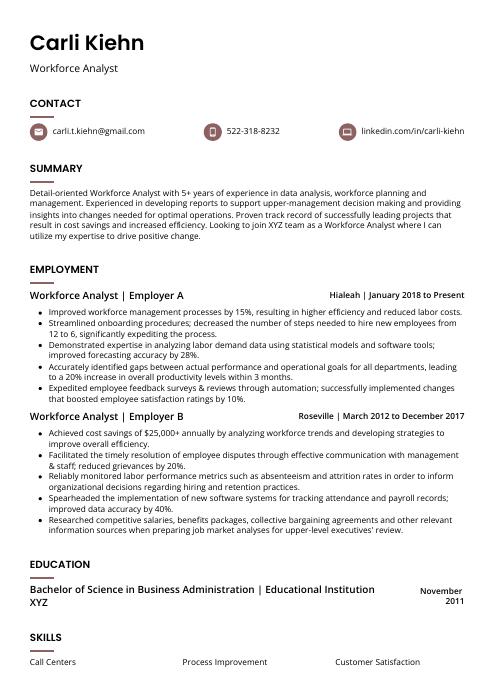 Fossa
Fossa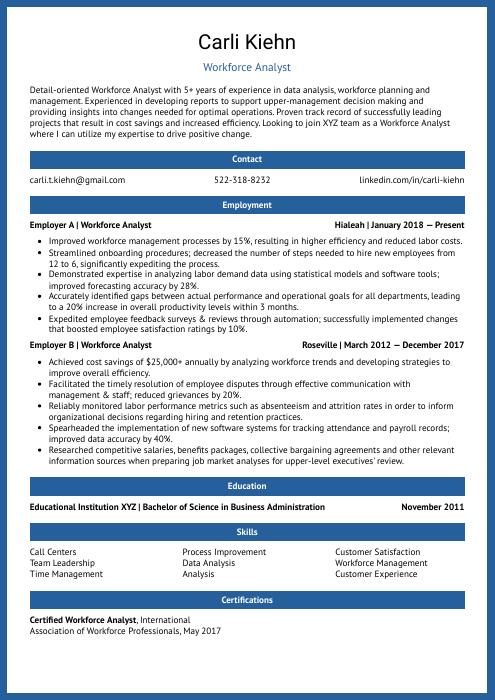 Ocelot
Ocelot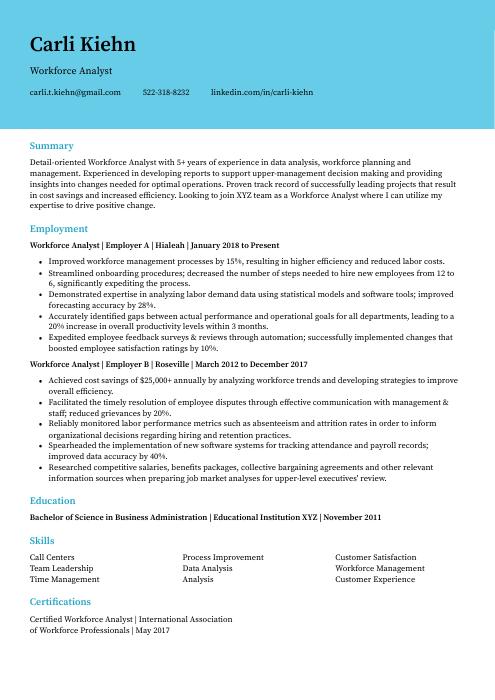 Dugong
Dugong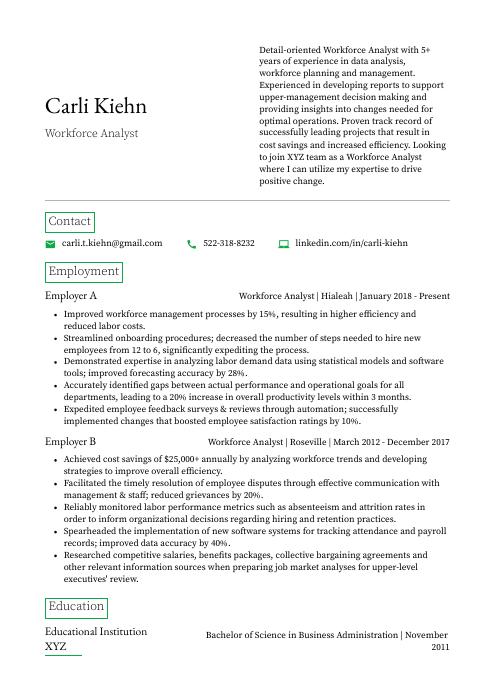 Quokka
Quokka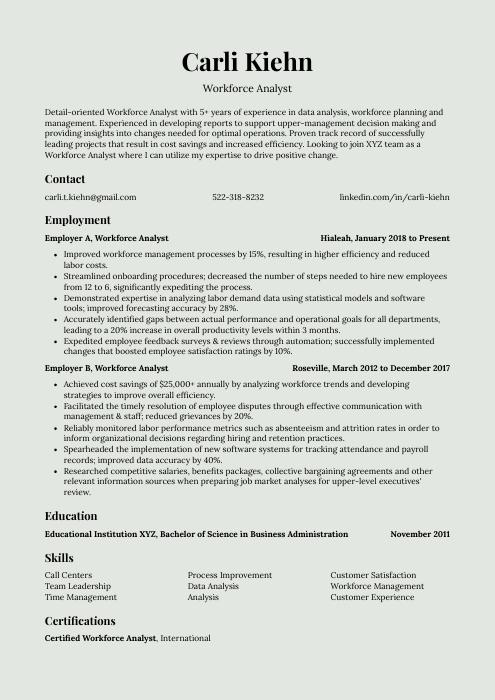 Saola
Saola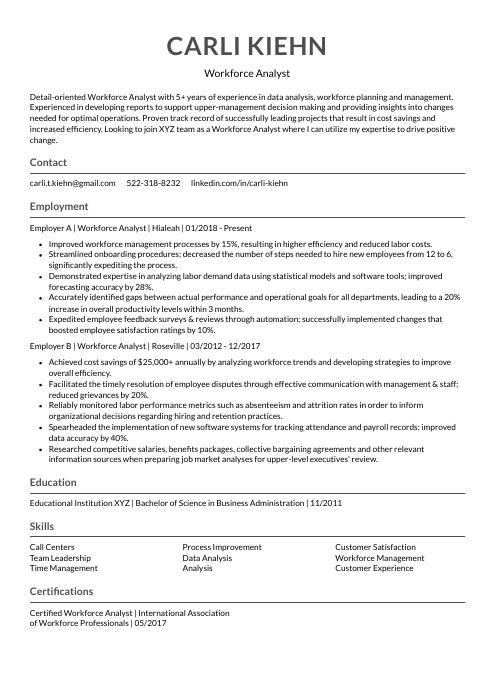 Indri
Indri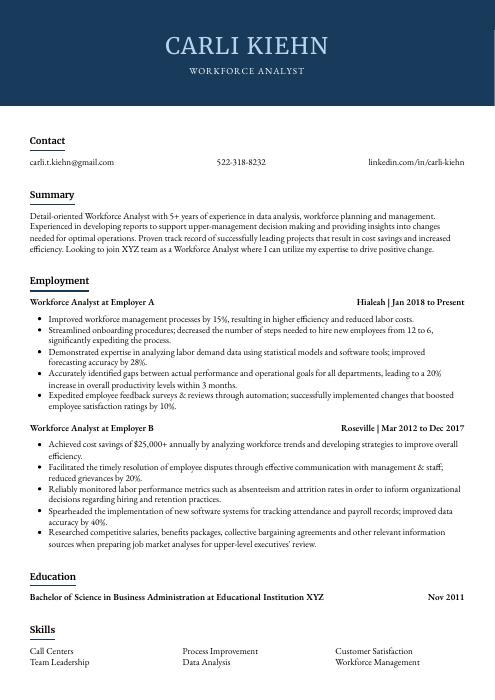 Bonobo
Bonobo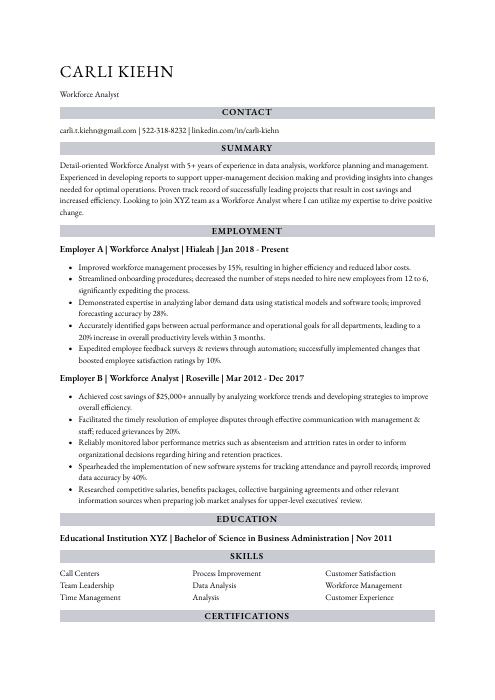 Numbat
Numbat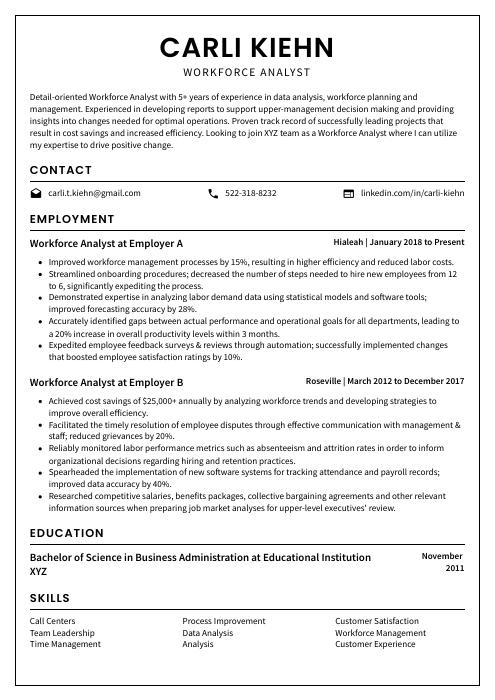 Cormorant
Cormorant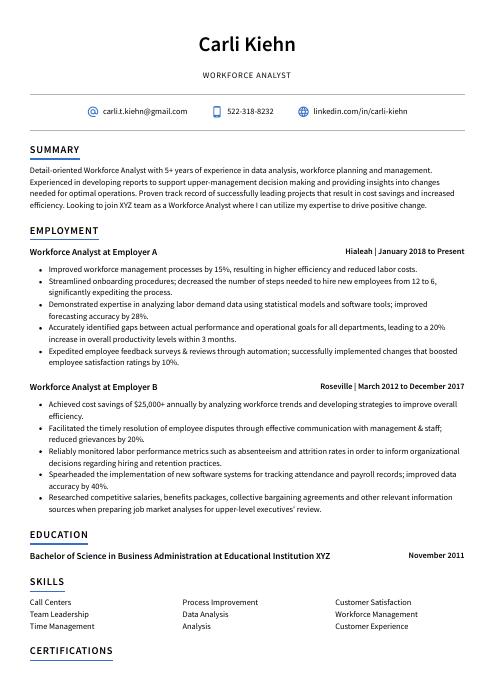 Axolotl
Axolotl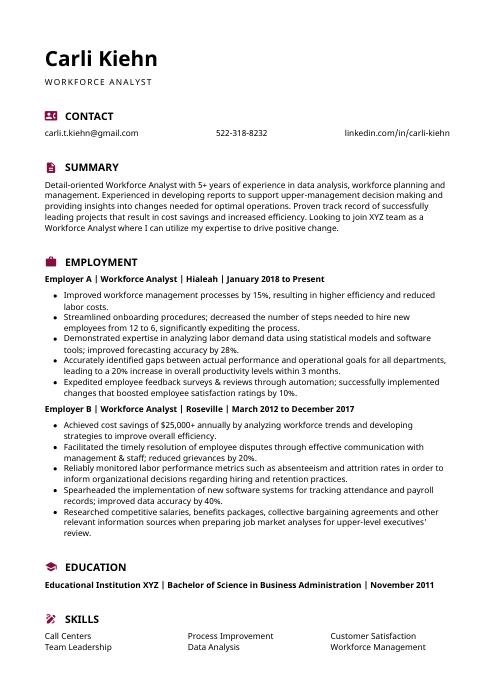 Hoopoe
Hoopoe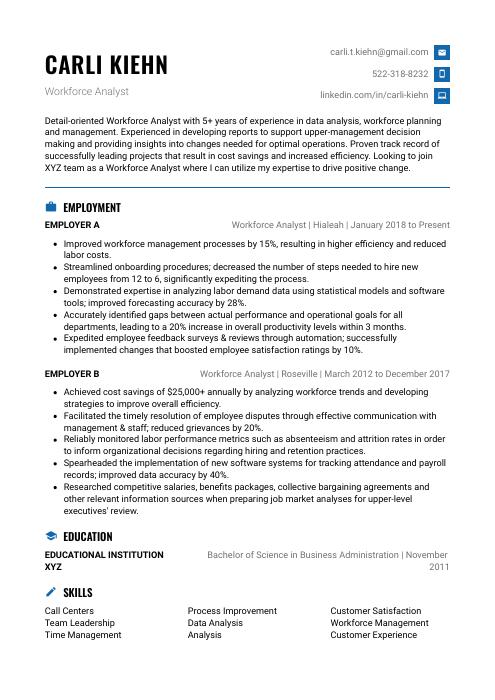 Echidna
Echidna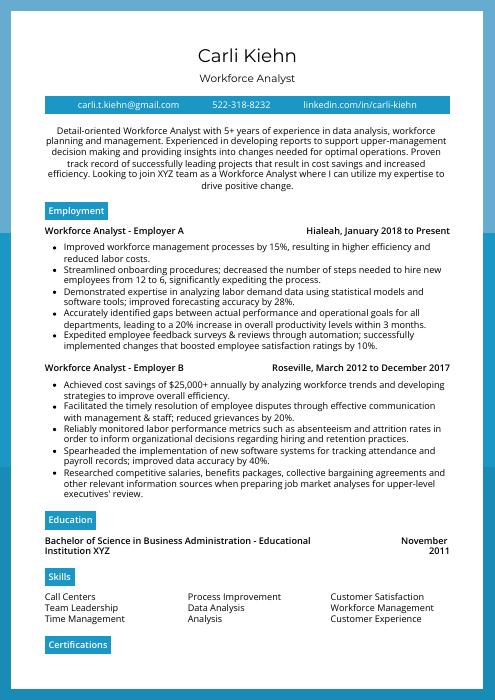 Rhea
Rhea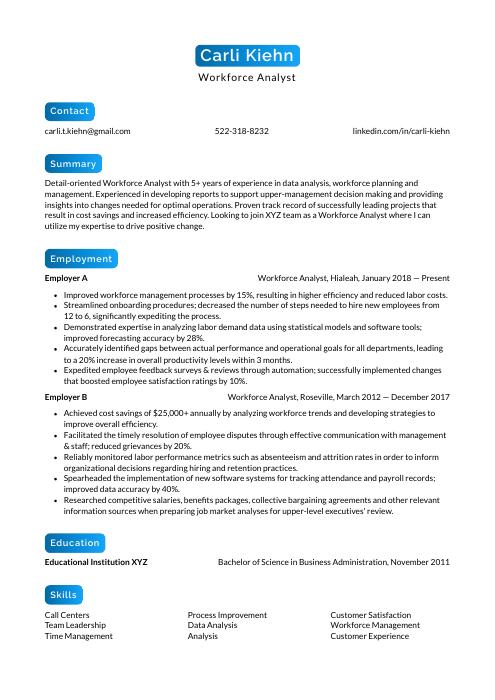 Kinkajou
Kinkajou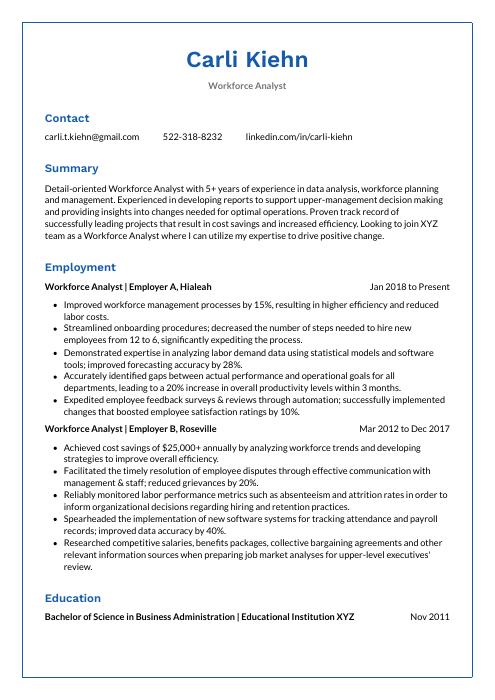 Markhor
Markhor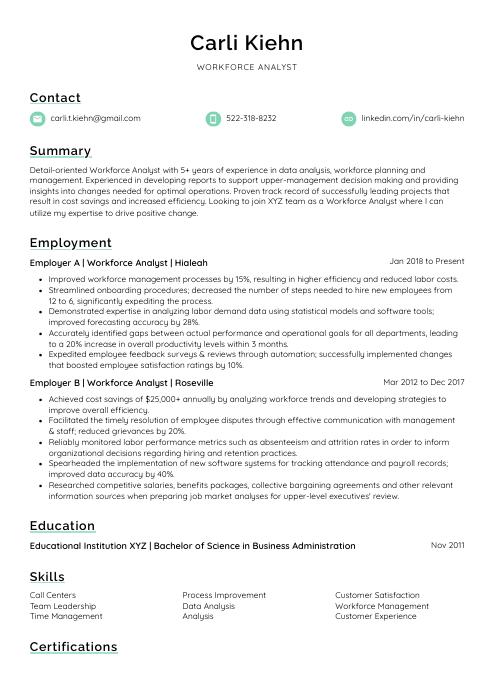 Lorikeet
Lorikeet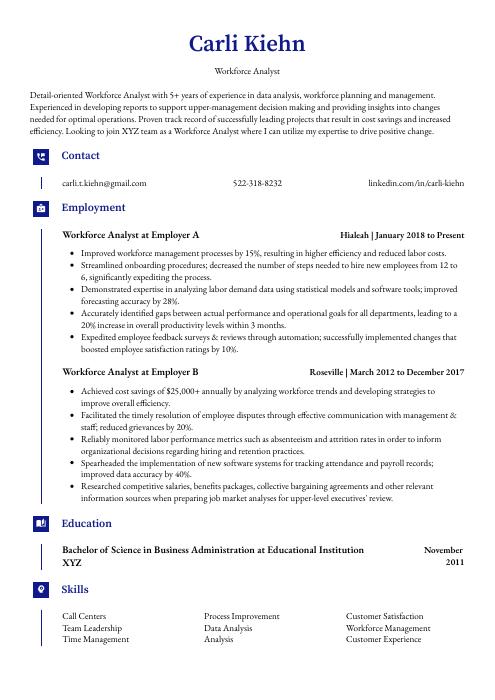 Gharial
Gharial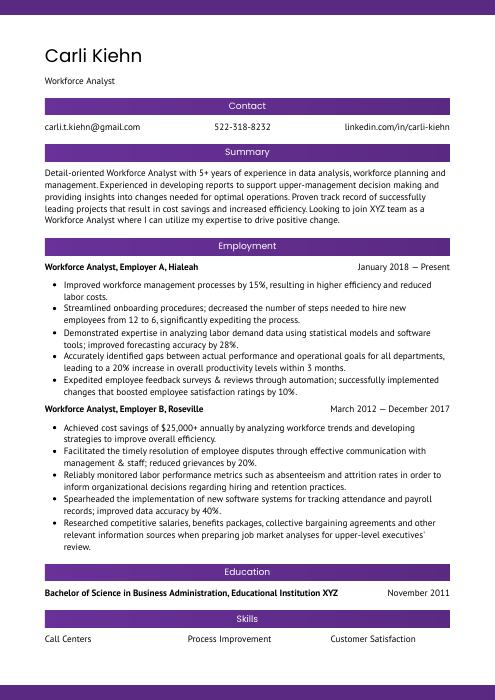 Jerboa
Jerboa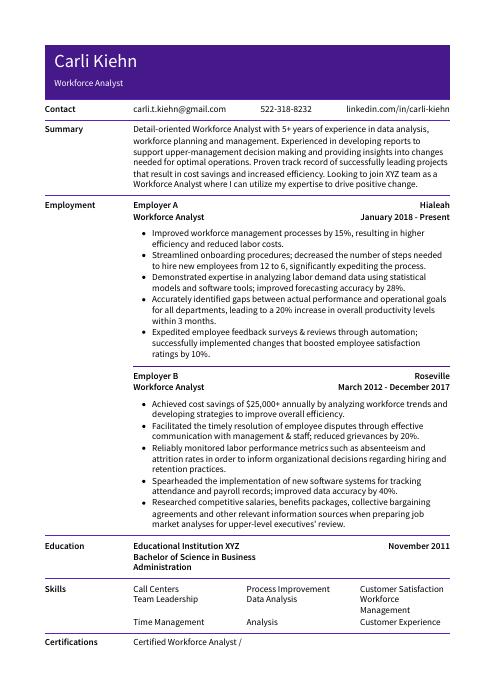 Pika
Pika Rezjumei
Rezjumei
